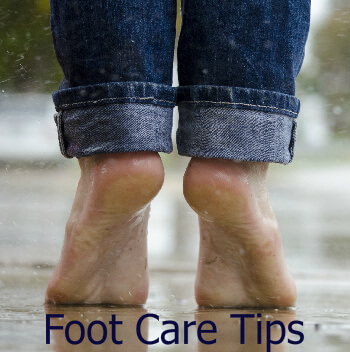Taking care of your feet will help keep them healthy and pain-free. Are the muscles of your feet flexible and strong? Unfortunately, most people ignore these muscles and their feet in general, leading to a wide range of foot problems, including bunions, hammertoes, and plantar fasciitis.
Tips for Taking Care of Your Feet
Practice good foot hygiene:
- Wash your feet well when you shower or bathe and dry them thoroughly.
- Examine your feet frequently, checking for blisters, redness, small cuts, cracked skin, and other problems. Address any issues promptly to avoid worsening problems.
- Use a moisturizing lotion on your feet as needed after showers or baths — do not use lotion between the toes as it might promote fungus growth. Moisturizing becomes more important as you get older because the feet’s skin can become thinner and drier with age.
- Gently remove calluses using a pumice stone or foot file.
- Trim toenails straight across to prevent ingrown nails.
- If you wear toenail polish, when you remove it, let the nails air out for a day or two before adding new polish.
Perhaps the best thing you can do for your feet is wear supportive, comfortable shoes shoes most of the time and well-fitting athletic shoes for running, aerobics, and other high-impact activities. While occasionally wearing high heels or tight shoes for short periods won’t cause lasting damage, the more you wear them, the greater your risk of not only foot problems but also knee, hip, and back pain.
Stretch and Exercise Your Feet
Can you pick up a small towel using only your toes? It’s a great exercise. See this Foot and Ankle Conditioning Program from the American Academy of Orthopaedic Surgeons.
If you have flat feet, see exercises for flat feet at Somatic Reflections.
Understand Pronation and Supination
It’s important for your feet to have the right amount of pronation
and supination — the foot’s natural rolling movement while walking
or running. Too much pronation or supination causes a number of
problems that affect your feet, ankles, knees, hips, and back.
Pronation
is the inward roll of the foot during normal foot movement. Too much
pronation flattens the foot arch and overstretches the muscles, tendons,
and ligaments on the bottom of the foot.
Supination is the
outward roll of the foot during normal foot movement. Too much
supination strains the muscles and tendons that stabilize the ankle and
can lead to ankle injury.
Learn more pronation and supination and choosing footwear.
Soak Your Feet
For a relaxing foot soak, add Epsom salts to a basin of warm water
and soak your feet and ankles for at least ten minutes. You can also add
a few drops of essential oils diluted in a few drops carrier oil. Some suggestions:
- To soothe tired, aching feet: 7 drops rosemary
- To warm up your feet: 3 drops ginger
- To refresh your feet: 5 drops peppermint
- To soothe an injury: 8 drops lavender
- To relax your feet: 4 drops Roman chamomile
For
a foot scrub to exfoliate and invigorate, blend a little olive oil, a
tablespoon of sea salt, and a drop of your favorite essential oil. Scrub
your lower leg and the bottom of your feet.
More: Foot Scrub Recipes and Foot Soaks and Essential Oils for Feet.
Massage Your Feet
A benefit of foot massage is it can make your entire body feel better. This effect is due at least partly to the feet’s many nerve endings that send relaxation signals to the rest of the body.
Note: Although reflexology is sometimes referred to as massaging the feet, real reflexology isn’t massage but an energetic technique that uses pressure on specific points on the feet (and hands and ears) to affect the whole body. However, many massage therapists do combine reflexology and massage techniques.
Foot Care for Diabetes
People with diabetes are prone to foot problems because of decreased circulation to the feet. eMedicine offers tips for taking care of your feet if you have diabetes:
- Look at your feet every day and immediately after any foot trauma. Let your doctor know if you find potential problems.
- Wear cotton or wool socks. Don’t wear elastic socks and hosiery, because they can interfere with circulation.
- Apply a water-based moisturizer to your feet every day (NOT between your toes) to prevent dry skin and cracking.
- Keep floors and pathways clear and lit so that you don’t bump into or trip over things.
- Trim your toenails with a safety clipper, not scissors. Cut the nails straight across with lots of space out from the nail bed or quick.
- Wear sturdy, comfortable, properly fitted shoes to protect your feet. A podiatrist (foot doctor) can help you fit shoes properly.
- Exercise to improve circulation to your legs and help stabilize your blood sugar.
People with diabetes can receive gentle foot massage as long as there are no problems such as excess swelling or lack of feeling. If in doubt, ask your doctor.
